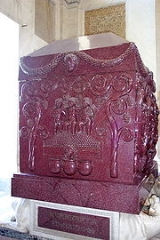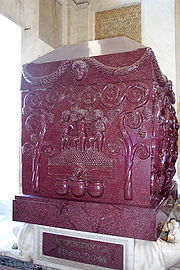
Early Christian sarcophagi
Encyclopedia

Early Christianity
Early Christianity is generally considered as Christianity before 325. The New Testament's Book of Acts and Epistle to the Galatians records that the first Christian community was centered in Jerusalem and its leaders included James, Peter and John....
through to the 5th century, particularly known via 3rd century examples.
The production of Roman sarcophagi with carved decoration spread due to the gradual abandonment of the rite of cremation in favour of inhumation over the course of the 2nd century throughout the empire. However, burial in such sarcophagi was expensive and thus reserved for wealthy families. The end of the Christian persecutions desired by Gallienus
Gallienus
Gallienus was Roman Emperor with his father Valerian from 253 to 260, and alone from 260 to 268. He took control of the Empire at a time when it was undergoing great crisis...
in 260 began a period of peace for the Christians that lasted until the end of that century and allowed Christianity to spread in the army, in senior administrative posts and even the emperor's circles. In the second half of the 3rd century, especially due to increased demand from this group of wealthy Christians, the use of sarcophagi spread widely, with plastic treatments following trends in contemporary sculpture.
Notable examples
- Sarcophagi of Helena and Constantina
- Sarcophagus of Santa Maria AntiquaSanta Maria AntiquaThe Ancient church of St Mary is a Roman Catholic Marian church in Rome, built in the 5th century in the Forum Romanum, and for long time the monumental access to the Palatine imperial palaces....
- Sarcophagus of StilichoStilichoFlavius Stilicho was a high-ranking general , Patrician and Consul of the Western Roman Empire, notably of Vandal birth. Despised by the Roman population for his Germanic ancestry and Arian beliefs, Stilicho was in 408 executed along with his wife and son...
- Dogmatic SarcophagusDogmatic sarcophagusThe Dogmatic Sarcophagus, also known as the "Trinity Sarcophagus" is an early Christian sarcophagus of about 320–350, now in the Vatican Museums...
- Sarcophagus of the Good ShepherdGood ShepherdGood Shepherd may refer to:In Christianity:* The Good Shepherd , pericope found in John 10:1-21, and a popular image in which the Good Shepherd represents Jesus...
- Sarcophagus with the miracles of Christ
- Sarcophagus of Junius BassusSarcophagus of Junius BassusThe Sarcophagus of Junius Bassus is a marble Early Christian sarcophagus used for the burial of Junius Bassus, who died in 359. It has been described as "probably the single most famous piece of early Christian relief sculpture." The sarcophagus was originally placed in or under Old St...

- Sarcophagus of the Passion

